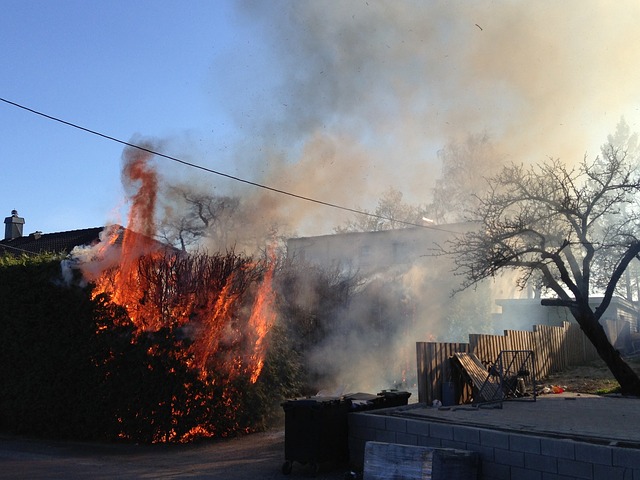|
|
|
The only way to reduce the devastation of a fire is to be prepared. The more you prepare, the better
your chances of reducing suffering and risk for yourself, your family, your animals and your community.

|
Anyone whoís seen the news from California lately knows how dangerous wildfires can be, how quickly they can spread, and the devastation they leave behind. California state Senator Mike McGuire recently reported that total losses in Sonoma County alone top $3 billion. [1] Across Northern California, at least 40 people have been killed, more than 5,700 structures have been destroyed and approximately 217,000 acres left burned. For homeowners, the threat of fire is just one part of the equation. Landslides, flooding and debris present residual dangers. Protecting your home and family from wildfires and their aftermath can be difficult, but there are steps you can take to prepare for the unthinkable. Protect your perimeter Your home and the area immediately around it have a lot to do with whether your home can survive a wildfire. The Home Ignition Zone [2] is defined as the resilience of the space around your house and the likelihood that it will ignite. Your first act should be to reduce the number of ignitable substances within the Home Ignition Zone, objects that can feed an advancing fire. Get rid of residue from the trimming of shrubs, trees or bushes, and be sure that any stacked firewood is at least 35 feet away from your home. Make sure that all external vents are in good working order. Post a sign, using flame-resistant material, at the end of your driveway that includes your name and contact information so that fire department and emergency officials can contact you, if needed. Annual maintenance If you live in an area thatís vulnerable to wildfires, itís important to perform basic maintenance checks to ensure your house is as prepared as possible. Keep your gutters and roof clear of sticks, bracken and other debris, and mow your lawn to a height of no more than 6 inches. Youíll also need to cut away all branches [3] (they should be at least 10 feet away from the house) that hang near your roofline and anything else that could facilitate the spread of a fire. Have an action plan A wildfire can move very rapidly and may change direction at any time; all the more reason to have a well-rehearsed safety action plan in place. Begin with a fire safety checklist that includes everything from upkeep on smoke detectors and fire extinguishers to a family evacuation route [4]. One of the most important parts of any escape plan is to practice it, since oneís sense of direction can easily become confused in the smoke and heat of a fire. Itís essential to review your plan if you have young children - make sure they know exactly where your family meeting point is, where all the exits are and what to do if they get lost. Account for your pets Pets can become frightened and disoriented in a fire, too. Remember that their instincts will take over, and theyíll probably seek safety in a closet or under a bed. Be sure to incorporate them in your evacuation plan so that someone is responsible for keeping track of them, but keep a door or window open so they can escape if they canít be located. Rover.com recommends [5] checking to make sure that your dog or cat has its collar on with ID tags that include your petís name, address and your contact information. Preparation is the most important thing you can do to protect your home and family from the unpredictability of a wildfire. Safeguarding your houseís exterior and maintaining a coordinated escape plan can help you and your loved ones ward off disaster. Photo Courtesy of Pixabay.com. [6] Article reprinted with permission. Getting Started: 1 - Home Preparation Tips for Weather Emergencies 2 - Burn, rake or mow? A seasonal question 3 - Fire Safety on the Farm 4 - Fireworks Safety 5 - Grilling Safety Tips: Stay Safe at Home This Summer 6 - Fire Safety Tips: The Camperís Handy Guide to Fire Safety Outdoors 7 - Fire Prevention, Preparedness & Recovery 8 - Fire Safety Guide 9 - Before and After the Wildfire - resources More links: How to Clean Smoke Detectors Kitchen Fire Safety Guide (Thanks, Max!) Barbecue Safety Fire Safety Guide Camping Tips Wildfire Preparedness How to Prevent Kitchen Fires Fire Prevention Guide Survive Wildfire Season Fire Safety for Kids: Sparky the Fire Dog Open Campfire Safety Rules Fireplace and Chimney: Tips & Prevention Burn Prevention and Fire Safety Tips Fire Safety in the Home How to Escape a Burning Building Homeownersí Guide to Forest Fires Fire Safety for People with Disabilities: A How-to Guide for Prevention and Evacuation Space heater safety tips (infographic) Fire Safety for Farm and Livestock Owners Fire Safety: Early Lessons Save Young Lives The Ultimate Guide to Fire-Safe Landscaping The Ultimate Fire Safety and Disabilities Guide 20 Free Online Tools to Help Your Family Develop a Fire Safety Plan Safe Cleanup of Fire Ash and Debris Wildfire Safety Guide Fire Safety Guide Fire Preparedness for Those With Disabilities An Ultimate Guide To Home Fire Safety Don't forget to include your pets and any animals in your care when planning your safety measures. |